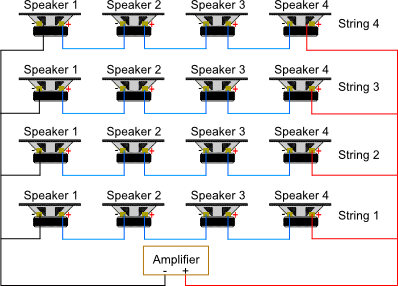This calculator for speakers in series/parallel is a combination of my popular Speakers in Parallel Calculator and my recent Speakers in Series Calculator. It allows you to try various combinations of your speakers in series and parallel to see what the total impedance will be and what effect such a configuration will have on your amplifier.
In fact this could be your on-stop calculator for speaker impedance as it allows you to calculate:
- up to 4 speakers in series, or
- up to 4 speakers in parallel, or
- up to 4 speakers in series in parallel with up to 3 others strings of series speakers.

Not that I normally recommend or condone connecting 16 speakers together this way. But for those readers who like to play around with various scenarios, this calculator will be useful. If nothing else, it will help you realise the problems with connecting so many speakers in series/parallel.
The normal use of connecting speakers in series/parallel is to allow, say, four speakers to be directly connected to a Hi-Fi amplifier without causing overload issues due to impedance. Remember, the total load impedance should be above the designed impedance for your amp. That is, if your amp is specified as 80 watts @ 6 ohms, the total load impedance should be 6 ohms or above.
Impedance Calculator for Speakers in Series/Parallel
Simply type the impedance of each speaker into the white boxes (or use the drop-down values). Use N/A for unused speakers in this calculator. The total impedance of each string will be calculated as will the total load impedance of your configuration. Tip: if only using two strings of speakers in series, ignore the top two strings and only use the bottom two strings.
Also calculated for each speaker is its percentage share of the amplifier’s output power. This is useful as power sharing is a consideration when using speakers with different impedance.
The difference in level between the highest and lowest power through the speakers is also calculated. This is shown in watts and in decibels (dB). This shows the power level difference when using speakers with different impedance.
Amplifier Power Calculator
The bottom section of the calculator helps in matching the speaker combination with your amplifier. This is not necessary if you only want to know the total impedance and/or the power ratios.
However, if you are connecting these speakers to your Hi-Fi amplifier, it may be helpful to input the amplifier power and the associated speaker impedance. In the specifications for your amplifier, it should say something like :
Amplifier power: 80 watts continuous average power @ 6 ohms (2 channels driven, THD 0.08%, 20Hz-20kHz)
This tells you the maximum continuous power the amplifier will deliver into a 6 ohm load is 80 watts. In the calculator below, for this example, you type in 80 for the power and 6 for the impedance. Be aware, some specifications state RMS power rather than continuous power. These are effectively the same.
The calculator will display the effective power of the amplifier for the calculated total impedance of the speakers. Also displayed (under each speaker’s power %) is the actual maximum power the amplifier will supply each connected speaker. A comment on the suitability of the calculated total impedance for your amplifier is also provided.
Note: the calculator is best viewed in landscape mode on phones and small screens
Note: the calculated output power for the amplifier is based on a theoretical “ideal” amplifier. In practise, your amplifier may produce slightly more or less power.
Need to know more?
This calculator will help you understand the total speaker load on your HiFi amplifier. For a better understanding of this and what to do about it, read the articles How do I Connect Multiple Speakers to my HiFi Amplifier and How to wire four HiFi speakers or How to connect 2 speakers to one amplifier or watch the video in the article Understanding Speaker Impedance. .
Also see How Multiple Speakers Share Power for further details about the percentage power calculations. For more details about the effective amplifier power at higher impedance loads, see How Impedance Changes Amplifier Power.
If you need further advice on connecting speakers in series, please read the FAQs before submitting your question.
